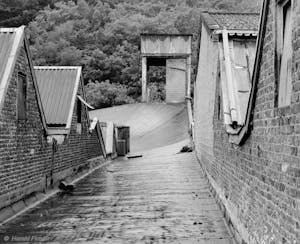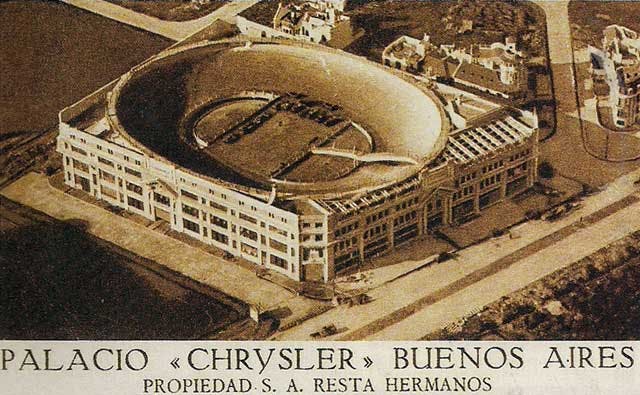These 3 rooftop test tracks will blow your mind
It’s difficult to design, develop, and manufacture cars without some kind of test track, and it’s nice to have one close to development and manufacturing facilities. When the Dodge brothers broke away from supplying Henry Ford to start making their own self-branded automobiles in 1914, one of the first things that they did was construct a test track right next to the Dodge Main factory in the Detroit enclave of Hamtramck. It was “paved” with wooden boards and had an elevated section to simulate hill climbing. Dodge’s wooden-slatted circuit was the first automotive test track in the world to be built on the grounds of a car factory.

Ford converted Ford Airport, on the grounds of its own Dearborn complex, to what would become the Dearborn Proving Grounds in the late 1930s. Packard, on the other hand, decided to build a modern, high-speed, 2.5-mile squared oval test track—as fast as the speedway in Indianapolis, in fact—at what it named the Packard Proving Grounds in Shelby Township, about 20 miles north of the Packard plant on Detroit’s east side. Packard even built a small private airport on the track’s infield and constructed an engineering lab adjacent to the track. As Detroit and its suburbs developed, the major automakers followed Packard’s lead, taking advantage of the open spaces in the regions beyond the city. In 1924 General Motors started developing its 4000-acre proving grounds in Milford, about a half hour northwest of Detroit. A bit farther west, Chrysler dedicated a 3850-acre facility in Chelsea in 1954, and Ford built its own exurban test track on its 3880-acre proving grounds in Romeo soon after.
Not every car company had the option of using thousands of acres of land for testing, and while there are all sorts of tests that can be accomplished at a large test track, including high-speed and endurance testing, it’s also nice to be able to do some immediate real-world testing. For example, in addition to Ford’s tracks in Dearborn and Romeo, its transmission plant in Livonia, Michigan, also has its own little-known, oval test track right next door.
If next door is convenient, how about putting the test track in—or I should say on—the factory itself? Might not have been your first thought, but that’s exactly what at least three car companies did in Italy, Argentina, and Belgium: They put test tracks on the roofs of their factories.
The first, Fiat’s former Lingotto factory in the middle of Turin, is fairly well known even to some folks who aren’t car enthusiasts. That’s because it was used as a filming location for part of the climactic chase scene in the original The Italian Job starring Michael Caine.

Lingotto is arguably the most famous building in Turin, a city so closely tied to Fiat that it is part of the company’s name: Fabbrica Italiana di Automobili Torino. The four-story factory stretches for half a kilometer. Designed by architect Giacomo Mattè Trucco in 1916 and finished in 1923, the Lingotto plant had an assembly line that started at ground level and spiraled up to the top floor where the finished cars would be driven out for testing on the banked oval track on the roof. Two ramps led from the roof down to street level.
With the construction of Fiat’s giant Mirafiori plant, Lingotto, whose multi-story design proved to be less than efficient, became superfluous and production ended there in 1979. Still, more than a million Fiats were produced at Lingotto in the intervening years, each one tested on the rooftop track. It’s even rumored that some high performance and racing cars were tested up there, despite the track’s paperclip profile. For an industrial building, Lingotto is fairly attractive, which partly explains why it was repurposed as a hotel, shopping center, and convention facility. Though no longer in regular use, Lingotto’s rooftop test track is still extant.
The same can’t be said for the Argentinian entry in this trio of test tracks that topped car factories. Just five years after the first car ran on the roof of Lingotto, in 1928 the then-new Chrysler corporation’s distributor in Argentina opened the Palacio Chrysler in the Palermo Chico neighborhood of Buenos Aires. A multipurpose, three-story building, it had showrooms, administrative offices, warehouse space, and workshops for assembling knocked-down kits of Chrysler cars. Still more facilities provided repair and maintenance services. Palacio Chrysler was designed by Mario Palanti for entrepreneur Julio Fevre, who had secured the rights to represent the new automaker in Argentina. Fevre had Palanti put a deep, bowl-shaped roof on the building, which had a mile-long banked test track at its rim and amphitheater space in the center for up to 3000 people to watch the cars run or to attend special events.
Unlike Lingotto, which was built in an already-bustling Turin, Fevre didn’t build a track on the roof of his building because of a lack of space on the ground. Period photography shows farmland adjacent to the Buenos Aires facility. The rooftop track on the Palacio Chrysler was likely there to promote cars at least as much as to test them.
Over the years the Palermo Chico neighborhood got built up and subsequently gentrified. In 1990 a development company took ownership of the Palacio Chrysler and started converting it to apartments, offices, and retail space, renaming the building Palacio Alcorta. The rooftop track and amphitheater were demolished, replaced with a swimming pool in the middle and apartments around the edges, where the track used to be.
I found out about a third rooftop test track when, offended by all the “ruin porn” that was being published about my hometown of Detroit—and particularly by photos of the old, abandoned Packard plant—I started looking for abandoned car factories in other parts of the world. I found one documented by photographer Harald Finster in Nessonvaux, near Liège, Belgium.

Have you ever heard of Impéria? Impéria was a Belgian automobile manufacturer that was in business from 1906 to 1957, making its own cars as well as others using components and designs licensed from companies like Adler, Hotchkiss, and Superior-Triumph. A major player in the Belgian auto industry during the interwar period, the company even briefly owned the highly regarded Minerva brand of luxury automobiles. Impéria also had a technical and financial association with the well-ahead-of-its-time Avions Voisin, giving it a foothold in the much larger French market.

Originally based in Liège, Impéria moved to Nessonvaux in 1907, where it remained for the rest of its history. Though not well known today, the company was innovative in its day, making a front-wheel-drive production vehicle as early as 1933 and producing one of the first closed cars with what we now call a sunroof. The company also raced, competing at the legendary Circuit de Spa-Francorchamps, placing two Impérias in the top 10 in the 1930 Belgian Grand Prix. Impéria’s chief research engineer, Louis de Monge, developed torsion bar suspensions and worked on an early automatic transmission. Hired away by none other than Ettore Bugatti, de Monge would go on to design the beautiful Bugatti 100P race airplane.
For the first two decades of its existence, Impéria tested its production cars on the public roads in and around Nessonvaux. Perhaps inspired by Lingotto and the Palacio Chrysler or, just as likely, due to the complaints of locals who didn’t want their town used as an automotive proving grounds, in 1928 Impéria built an almost 1 km-long banked test track on the perimeter of the sawtooth factory roof, running down to ground level where it circled the employee soccer pitch and then ran back up a section elevated on trellises to the roof. Residents of Nessonvaux would watch the cars from a nearby hillside as they ran around the track.
You can watch archival footage of cars being driven on the Impéria roof, in this French language video, and in a longer documentary about the company in Dutch and French (skip to here).
In 2009 a revival of the Impéria brand was announced, with the retro-styled, hybrid Impéria GP said to go on sale in 2013. So far, however, it appears that the revived company stalled at the prototype stage; its website has not been updated since 2015. It’s not clear, however, if those prototypes ever ran on the roof at the old Impéria factory in Nessonvaux. Come to think of it, that would have been a great PR stunt.
According to a comment on a post about the company at prewarcar.com, the current owner of the Impéria factory is planning on demolishing most of the building. For the time being—at least per Google maps’ latest satellite photos—the rooftop sections of the Impéria test track still exist.
Lingotto and Palacio Chrysler were both multi-story factories. Today, automotive assembly plants are sprawling, single-level affairs that occupy millions of square feet—more than enough to put a decent-sized test track on the roof. That’s not going to happen, though, since every major automaker in the world has at least one large-scale proving grounds. Even companies as small as Ferrari and Lotus have their own private tracks and independent companies and startups can rent time at facilities like Ohio’s Transportation Research Center or Aisin’s Fowlerville, Michigan test track.
We will likely never see another rooftop test track.







I watch the show on YouTube as so many do I’m sure. On this article which is a trip from the past. As a young person in Shelby Township my friends and I would ride our bikes to the packard test track and was able to ride on the wooden track. I still live in the area and have gone to the packard building which has weddings. Glad to see buildings like this are here.
The link to Google Satellite images is wrong – this one is correct: https://www.google.com/maps/place//@50.5738084,5.7450724,297m/data=!3m1!1e3?entry=ttu